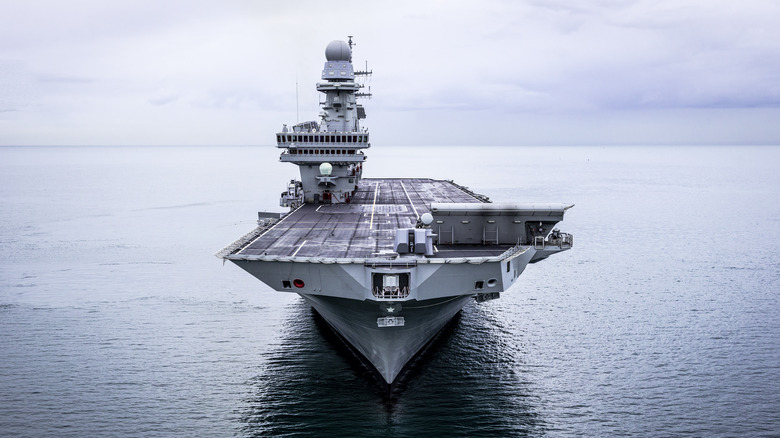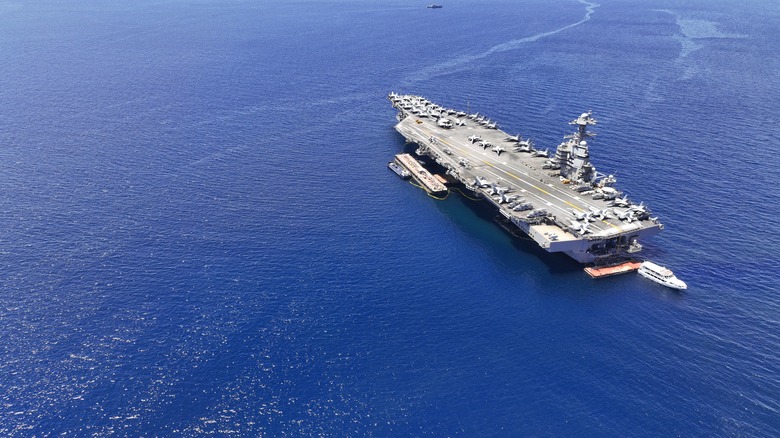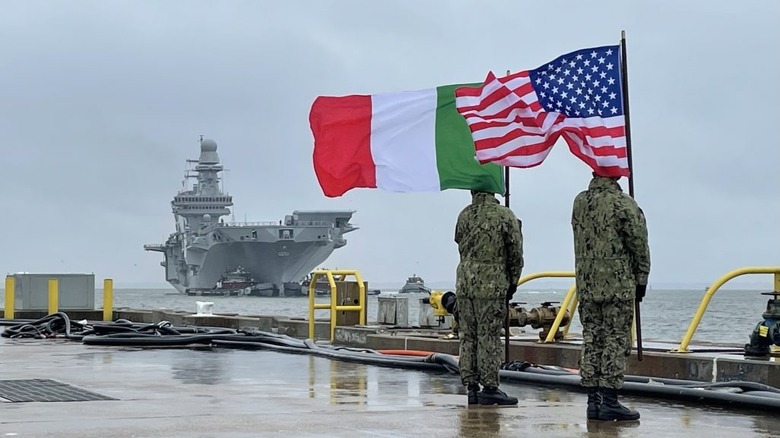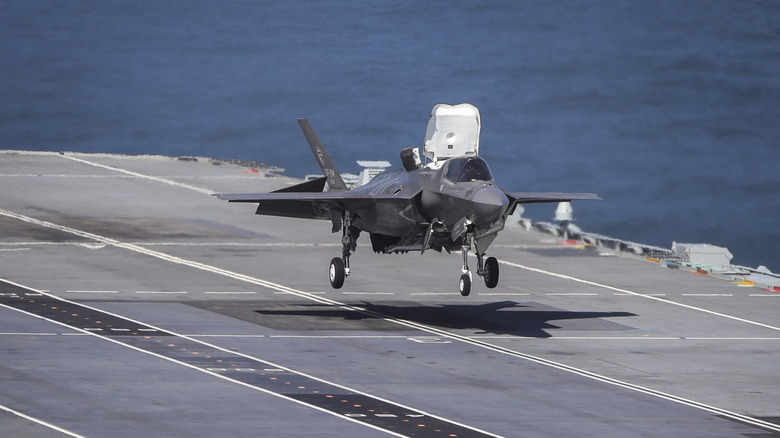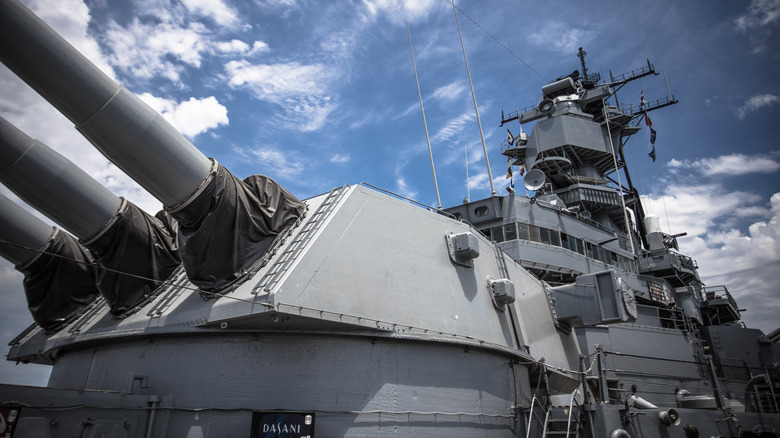How Does Italy's Flagship Aircraft Carrier 'Cavour' Compare To American Carriers?
America is known for its defense spending, which translates to a rather robust military presence worldwide. It's easy to do when the country spends more on defense than the total amount spent by the next nine countries, half of which are allies. It's not too surprising then to hear that some other countries with aircraft carriers, like Italy, only have two in their entire arsenal. Of the two, the ITS Cavour is Italy's flagship carrier. Its pride and joy. Compared to the country's other carrier, the Giuseppe Garibaldi, it's a giant. However, when compared to the biggest aircraft carriers in the world, the Cavour is the metaphorical David in a sea of Goliaths. American carriers alone dwarf the Cavour by tens of thousands of tons.
The ITS Cavour has a full load displacement of 28,100 tons whereas the USS Gerald R. Ford displaces 100,000 tons. To put that into perspective, the Italian carrier's full length is almost 300 feet shorter at 800 feet (244 meters), and its beam is 127 feet (39 meters), just seven feet shy of matching the largest aircraft carrier in the world. Being so much smaller than its American counterpart also means that it doesn't house nearly as many aircraft or crew members. With the Cavour fully loaded, it doesn't even hold 1,300 crew members (1,292, to be exact) while the Ford-class carriers can accommodate 4,660 personnel.
It's not only the size of Italy's flagship carrier that differentiates itself from American ones. Some other notable physical features and specifications also set it apart.
America's primary aircraft carriers
For some perspective, the two classes of aircraft carriers that America uses today are the Nimitz-class and Ford-class carrier. Ford-class carriers are the newest in the fleet, with the first of its class, the USS Gerald R. Ford, being commissioned in July 2017. The USS Nimitz, on the other hand, is nearly 50 years old, serving America since 1975. Meanwhile, the newest of the Nimitz carriers, the USS George H.W. Bush, was commissioned in January 2009. With nuclear carriers capable of functioning for 50 years (or more in the case of the USS Nimitz), Nimitz-class carriers aren't going anywhere for some time.
Both class of ships are 1,092 feet long with a beam of 134 feet and angled flight decks popularized in 1955 with the launch of the USS Forrestal and HMS Ark Royal. Where Ford-class carriers differ from their predecessors is the catapult system and 22 other new innovations. Ford-class carriers moved away from the steam catapult system that many carriers are known for when launching aircraft from the flight deck. Instead, they utilize what's known as the electromagnetic aircraft launch system (EMALS). This and its other new systems are intended to help Ford-class carriers function with a 20% smaller crew than the Nimitz.
Ford-class carriers come armed with anti-ship interceptor missiles designed to stop missile attacks from other ships, a 20mm radar guided close-in weapon system, and Rolling Airframe Missiles.
The Cavour's source of power
Unlike every single American aircraft carrier, the ITS Cavour isn't nuclear-powered – America and France are the only two countries with nuclear carriers. Italy opted to go with a combined gas turbine and gas (COGAG) propulsion for power on the Cavour. There are four gas turbines that each produce 22,000kW, with a total of 88,000kW to the whole ship. They give the propulsion system enough power to generate 120,000 shaft horsepower and travel a maximum speed of 29 knots. The Gerald R. Ford, on the other hand, reaches 30 knots. A whole whopping one knot faster than its Italian counterpart.
A non-nuclear fuel source isn't as efficient compared to a nuclear-powered carrier, which only needs to return to port for a refuel every 20 to 25 years. If the Cavour travels at a consistent speed of 16 knots, it can expect to travel roughly 7,000 nautical miles before needing to top off. That's significantly more frequent refuels compared to the 25 years a Nimitz or Ford-class carrier can expect.
Unfortunately, the war between Russia and Ukraine has greatly affected imports to Europe, including the Cavour's fuel source. In 2021, more than 40% of Europe's natural gas was imported from Russia, but as of 2023, it's down to about 14%. This has forced Italy and other European countries to rely more on their Middle East imports. Thus, Italy is looking to expand the Cavour's area of operation, specifically in the Indo-Pacific region, to protect its fuel supplies.
[Featured image by US Navy via USNI News | Cropped and scaled | CC BY-NC-ND 4.0]
What aircraft does the Cavour carry?
The Cavour sets itself apart from American carriers in one big way. Ever since the construction of the USS Forrestal in 1955, all American carriers have used angled flight decks as a means to support aircrafts rapidly taking off and landing. Not the Cavour, though.
The Italian carrier has a straight runway much like carriers from World War II and prior. This is likely because the Cavour has exclusively worked with aircrafts capable of vertical takeoff and landings (VTOL). It started its commission in 2008 utilizing AV-8B Harriers, but as time went on, the Harrier found itself older and closer to being obsolete, especially when the F-35 program hovered its way onto the scene.
That's why the Cavour arrived in Norfolk in 2021, to work alongside the F-35 Joint Program Office (JPO) and get the Cavour certified to operate the F-35B. Along with the Harrier and F-35, the Cavour can also carry a variety of helicopters, including the EH101, NH 90, or SH-3D. VTOL technology is especially beneficial for naval aviation, allowing shipbuilders to construct carriers with shorter runways. Another notable feature the Cavour utilizes is a ski slope at the end of its runway to assist with takeoff, something American carriers don't use.
According to Naval Technology, "Landing operations are supported by the Telephonics AN/SPN-41A radio frequency all-weather instrument approach landing system and the Galileo Avionica SPN-720 advanced precision approach radar and the Thales tactical air navigation (TACAN) system."
Cavour's purpose
The ITS Cavour is currently participating in a series of war games, known as Exercise Pitch Black, along with the U.S., Britain, the Philippines, and Japan. Some of the F-35Bs aboard Cavour and a number of other Italian fighter jets are practicing dogfights over northern Australia, preparing pilots for future combat scenarios.
Since aircraft carriers are built for militaries, they're primarily used for military operations worldwide. American carriers, especially, are seen as an intimidating force. With their plethora of fighter jets aboard, and being armed to the teeth with defensive measures, it's hard to look at any carrier as a peaceful vessel.
However, when the Italian carrier strike group is done with Exercise Pitch Black on August 2, 2024, the Cavour will make its way to the Philippines where it will conduct a humanitarian operation. It's not uncommon for carriers to be used in humanitarian efforts as they have the space to take on passengers like doctors and patients, as well as the ability to rapidly transport personnel. The Cavour's effort will use its onboard hospital to provide surgeries for children.
Additionally, the Cavour can transport more than its F-35Bs to areas of operation with few issues. The hangars onboard can accommodate an assortment of land-based and amphibious vehicles just as easily as it carries around aircraft. The designers outfitted the carrier to fit up to 100 light vehicles or 24 main battle tanks below the flight deck whenever a mission calls for them.
[Featured image by US Navy via USNI News | Cropped and scaled | CC BY-NC-ND 4.0]
ITS Cavour's armament
Complementing the various aircraft found on the carrier, the Cavour comes armed with two Sylver eight-cell vertical launch systems that can launch Aster 15 missiles, anti-air missiles with a maximum speed of Mach 3 and a range of 18 miles (30 km). It also has two Oto Melara 76mm rapid fire gun systems as well as three 25mm anti-aircraft guns. The 76mm cannons can fire 85 rounds per minute.
The Cavour isn't without its own defenses either, as it's armed with a series of countermeasures in case it finds itself in an enemy's crosshair. It has two 20-barrel decoy launchers for 105mm or 118mm multipurpose rockets that confuse incoming missiles and give them another target to go after.
As for threats found under the water line, the Cavour uses two SLAT (Systeme de Lutte Anti-Torpolle) torpedo defense systems. Similar to flares fighter jets use against enemy aircraft, the SLAT system deploys decoys and jammers, deterring incoming torpedoes away from the carrier.
The Cavour might be the runt of the litter, if that litter were every American carrier and itself, but it packs quite a punch. It's certainly more than a mere stone.
